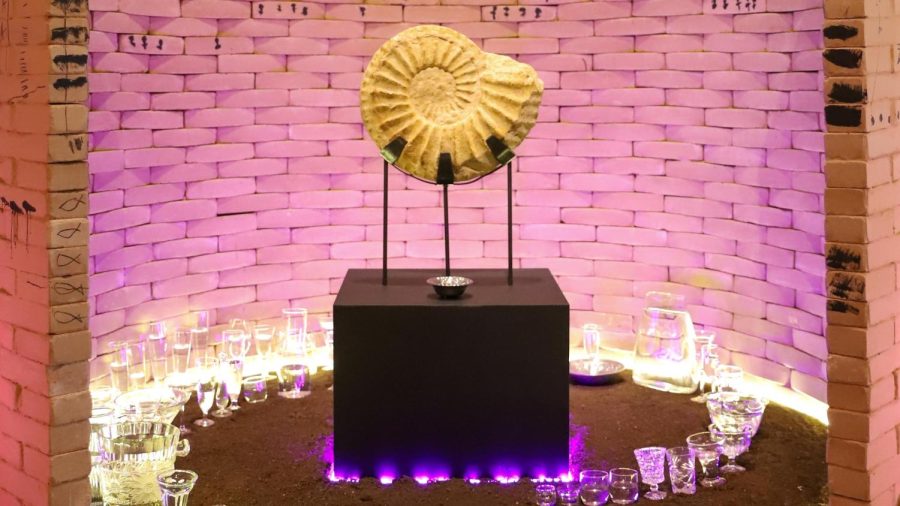Contemporary Brazilian art show Social Fabric highlights Brazilian politics, cultural awareness
October 4, 2022
The Visual Arts Center bustles with people weaving through rooms and admiring the larger-than-life pieces housed in the gallery space. A stunning installation titled “Jupiter is Here. Celestial is Everything.”created by Castiel Vitorino Brasileiro greets audiences immediately: a dirt path with large fossils leads to water-filled glasses enclosed in a towering sculpture made from upcycled materials.
Two-hundred-fifty terracotta sculptures displaying half-woman, half-silkworm beings climb the high walls of a space just a few rooms down, with their cocoons sitting at the feet of the viewer. The piece represents gender roles for women in Brazil.
Curated by Adele Nelson, an art history assistant professor, MacKenzie Stevens, the Visual Arts Center director and curatorial assistant Maria Emilia Fernandez, “Social Fabric: Art and Activism in Contemporary Brazil” showcases the works of 10 contemporary artists and conveys the swinging political climate of Brazil. Fernandez said the exhibit demonstrates the connection between art and social activism.
“It is an exhibition that thinks about activism and puts it into (the) question: How can art be connected to it?,” Fernandez said.
There are important ways to define activism, and creating something that can be seen symbolically is one of them, Fernandez said.
From its conception in 2018 to researching artists and finally assembling the gallery, Nelson said the project evolved over the course of a few years to accommodate disruptions posed by COVID-19. The curators originally planned to show the exhibit at the Brazilian Studies Association Conference, but Nelson said the team worked to develop a bigger showcase through largely virtual collaboration.
“MacKenzie Stevens suggested something bigger … not tethered to the conference,” Nelson said. Because of the pandemic, Nelson said their research was primarily online and through exhibition catalogs and they were in constant virtual dialogue with the artists.
Nelson said UT graduate students contributed immeasurable support, including researching artists, applying for grants and helping conceive a sociogram — a large, non-linear graphic diagram that depicts Brazil.
With help from an advisory committee composed of 15 people in the United States, Europe and Brazil, Nelson said the exhibit made a successful debut. In addition to this committee, UT staff helped curators in researching contemporary Brazil, and Nelson said this exhibit shows the integrative role of art in showcasing social activism.
“What we wanted to do — and what I hope we did — is have people start thinking of these artists as being in interdisciplinary conversations … and recognize the merits and necessities of interdisciplinary collaboration,” Nelson said. “The depth of expertise across this campus is mindblowing, and (the VAC) is a place on campus that creates interdisciplinary dialogue around visual art and all the various expertise around Brazil.”
Fernandez said she hopes that audiences can identify common social issues between Brazil and the United States despite their geographic separation from one another.
“I want us to train the way we’re thinking about these problems … our brains, our muscles to think about other histories and times. … It’s important to see that the past still shapes today. If we could see history projected around us, it would be radical,” Fernandez said.
Julian Munevar, a student raised in São Paulo, Brazil, said the exhibit encourages awareness for the complexity of Brazilian culture.
“Contemporary and Brazilian art has always been something I have really loved and identified with,” Munevar, the government and corporate communications sophomore said. “Giving it the space it deserves gives me goosebumps … something that has depth and meaning from my society being shown at my University … warms my heart, and it makes me feel a lot better to speak here.”












